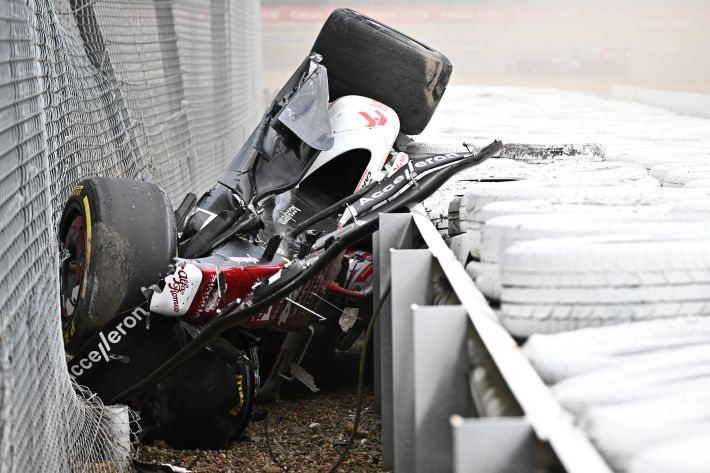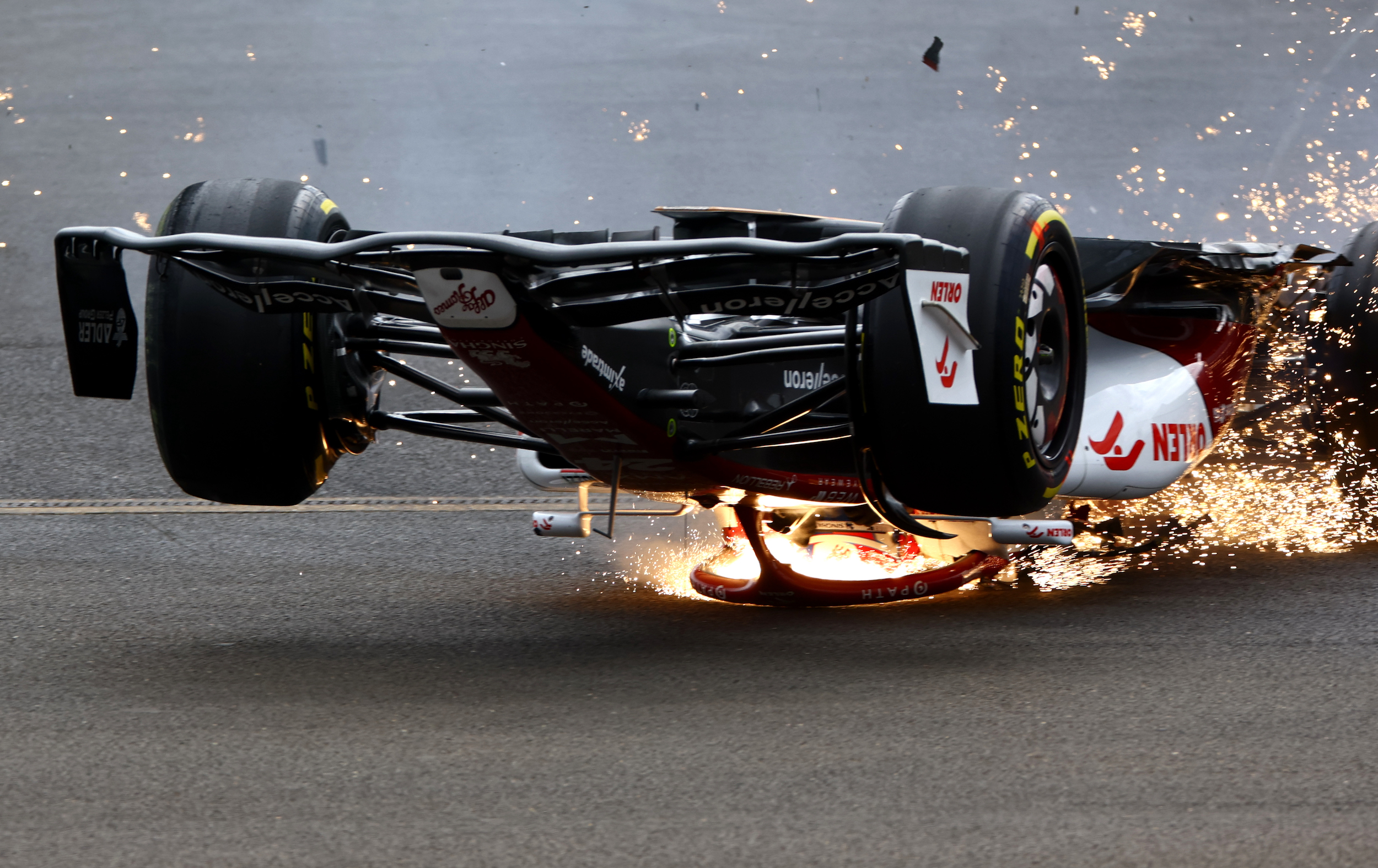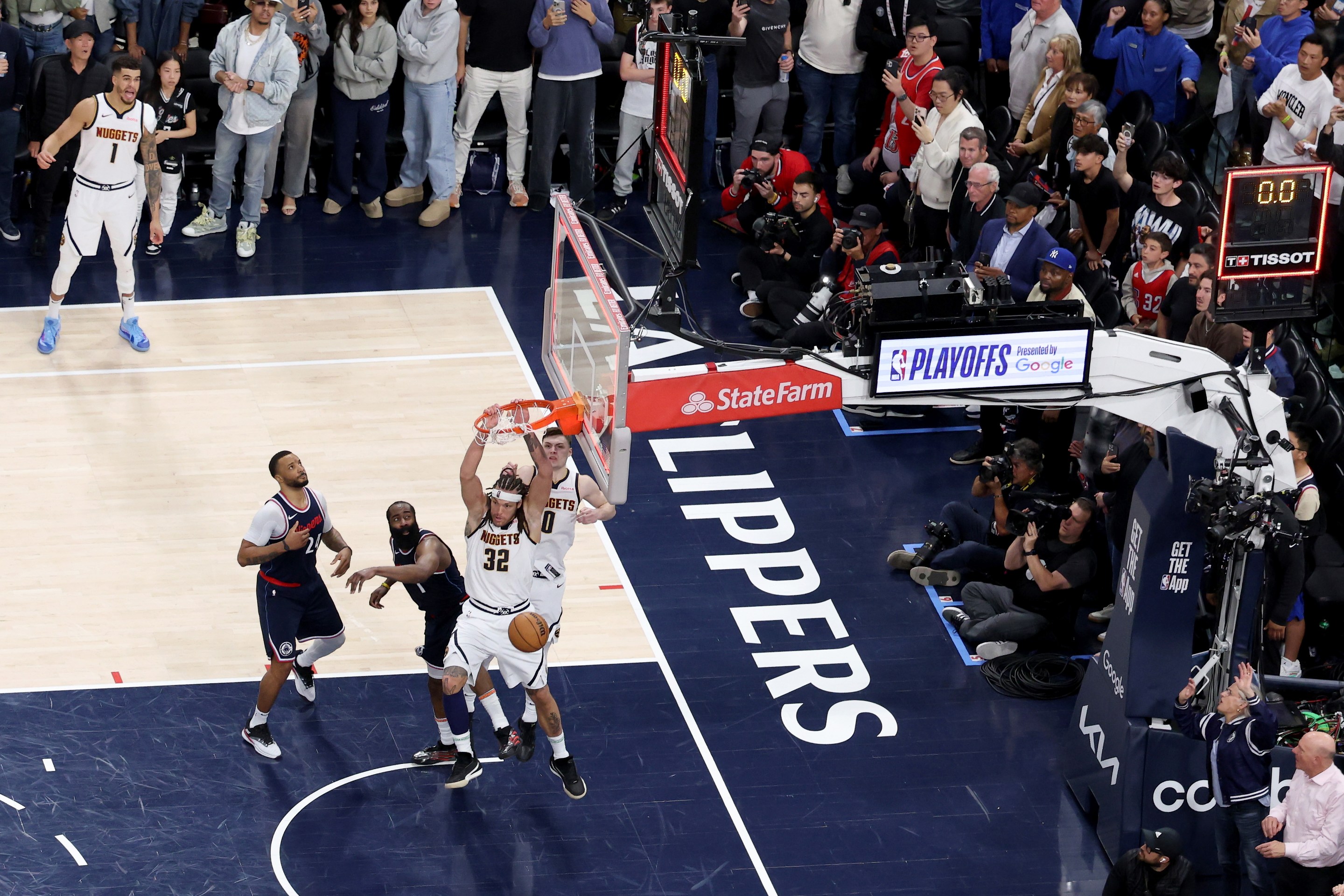Formula One rookie driver Zhou Guanyu is lucky to be alive today. Just seconds after the start of Sunday's British Grand Prix, Zhou's Alfa Romeo C42 was clipped in front of the right real wheel by the careening Mercedes of George Russell. Zhou's car immediately upended onto its open cockpit, spun in that deeply unfortunate orientation along and then off the track, ground through a patch of gravel, and then barrel-rolled up and over an impact barrier before finally smashing to a halt, crammed more-or-less on its side between a metal-and-tire barrier and a chain-link catch fence. Zhou—who despite cutting a literal groove in the tarmac emerged intact and mostly unscathed and will race again next weekend—credited his survival to the Halo cockpit protection (basically a titanium hoop positioned around and above the driver's helmet) added to Formula One cars in 2018.
This fan footage of Zhou's crash at Silverstone is terrifying 😧
— ESPN F1 (@ESPNF1) July 4, 2022
(via ted_meagher98/TikTok) pic.twitter.com/hkioNEUBkv
The race was red-flagged for nearly an hour, and ESPN waited a solid 30 minutes before broadcasting any images of Zhou's car—where Zhou remained stuck amid a whirring crowd of track personnel, paramedics, and a concerned but helpless Russell—or any replays of the accident itself. One by one, damaged cars from the bottom half of the grid limped back to pit lane, leaving television viewers to piece together what the hell happened based on their varying conditions. All but three cars managed to return under their own power: Zhou's C42 took the worst and most spectacular hit, but Russell's Mercedes W13 eventually had to be lifted and towed and retired, along with the Williams FW44 of Alex Albon. Once replays finally aired, almost as striking as the Alfa Romeo's top-down spin was just how violently and randomly the consequences of a very brief tussle between Russell and AlphaTauri's Pierre Gasly exploded outward to cars in their vicinity, and those hurtling along in their wake.
Something you'll notice right away in the replay is the huge discrepancies in launch performance out of the grid, and not even just in the neighborhood of the crash. Right at the front of the pack, the two Ferraris and the Red Bull of Sergio Pérez are molasses-slow off the line, allowing Max Verstappen to overtake Carlos Sainz and allowing Lewis Hamilton, who shot off the line like a bullet, to immediately jump two places and into third. The reflexes there are astounding—Hamilton is going from zero to 100 kilometers-per-hour in something like 2.5 seconds, and while the G-forces of that acceleration are flattening him against his seat and his circulatory system is surging into freak-out mode, he's got to have the wherewithal and precision to steer his vehicle into a moving and narrowing window of space between two competing drivers who in general are willing to risk their lives in order to protect track position. When this goes right—when a driver reflexively yanks their missile of a car into a temporary opening and emerges with their car and body intact—it looks like preparedness and strategy and opportunity coming together and producing a rational result. It looks like competition! While it also is that, at a very basic level it is survival. Lewis Hamilton very narrowly avoided rear-ending a car in front of him at terrific speed, and thus drove his way out of immediate danger.
In Hamilton's neighborhood on the grid, Fernando Alonzo and Lando Norris were also slow to start, and along with Checo formed into a little bundle behind the lead pack. Russell and Zhou, starting in P8 and P9 respectively, were also not among the quick starters. In a strange twist, it was hapless Mr. Magoo-ass Nicholas Latifi, starting in an unexpected P10 for Williams, who fired off the line, and like Hamilton he had the presence of mind—absolutely unheard of for this driver and this racing team—to bolt through a brief opening and gain track position. AlphaTauri's Pierre Gasly, in P11, saw Latifi zip between and past Russell and Zhou and figured he could shoot the same gap, despite a less impressive launch. Russell, perhaps to ease his way into the racing line or perhaps to close the gate he'd helped to open with his sloppy start, moved over on Gasly. Gasly was stuck in no-man's land, sandwiched between the rapidly converging cars of Zhou and Russell, until finally the front right wheel of his AT03 sent Russell pinwheeling across the track and into Zhou.
The thing that I want to point out, here, is that Zhou had not done really anything at all, let alone anything wrong. Of all the drivers in the top half-plus of the grid, he and Sainz were perhaps the only ones who had not moved from their lines. Zhou's launch was not great, but he was just moseying along on the left side of the track when Gasly went Latifi Mode and Russell drifted over to close him down. Aggression, in this instance, did not at all translate into increased personal danger. Latifi, for his boldness, was entirely clear of the collision, escaped all harm, and finished the race a somewhat disappointing 12th. Gasly, whose risky late plunge triggered the wreck, suffered only minor front-end damage, drove cautiously right through a cloud of spinning shrapnel, and with the extended red flag was able to join the restart and race his way into seventh place, before eventually retiring following an unrelated and extremely regrettable run-in with teammate Yuki Tsunoda. Russell, whose leftward drift arguably caused the whole ugly scene, was fit enough despite the wreckage of his car to haul himself free and sprint over to the barrier to check on Zhou. Zhou and Russell had the same crappy launch from the same row of the grid; one of them threw himself and his car in front of what appeared to be a temporary professional setback, and in a flash physics shifted the heaviest of the consequences onto the one of them who minded his own business and drove in a straight line.

Downstream, while the guy who stuck his nose into a snapping-shut death-trap took minor damage and rejoined the race, the cosmos selected one from half a dozen drivers who mashed their brakes to avoid disaster and rewarded him with catastrophe. Albon braked to avoid the chaos of the midfield collision and was rear-ended by Aston Martin's Sebastian Vettel. Which of them got it worse? Albon's Williams spun and plunged directly into a wall, and Albon spent most of the rest of the day in a hospital room, but is expected to race in the Austrian Grand Prix. Vettel squeezed past the scene via the clean inside of the first turn and eventually secured a ninth-place finish. McLaren's Daniel Ricciardo also braked in front of the collision and then somehow zoomed unscathed through the thickest of the debris cloud; Esteban Ocon, who started one row back of Ricciardo, braked to avoid rear-ending the McLaren, took the exact same line into Turn 1, and got wiped out by Albon's rebounding FW44, which missed Ricciardo's right rear wheel by inches.
This would all be much simpler to process—or, anyway, it would be far less frustrating in less extreme cases and somewhat less harrowing when shit goes fully haywire—if the whole picture of a crash like Sunday's could be understood in pure racing terms. Before cars collide, a race is ordered by mechanical capabilities, reflexes, and strategy. Once someone gets sideways in a crowd the effects are distributed more-or-less willy-nilly (this video on the Formula One website shows the accident from many different cockpit views, all of which are intense as hell). If any of a thousand tiny events had gone very slightly differently, a wreck on the opening straightaway Sunday would've had a completely different shape, and may have missed Zhou altogether. This is not to say that any of it is unjust, just slightly crazy-making. The first turn of any Grand Prix is always chaos. Even if good grid position did not tend to reflect car quality and did not tend to confer better odds of winning, pole position would still be worth fighting for just for a fleeting shot at a few seconds of reasonably straightforward racing, before that inevitable first encounter with Total Hell. Sunday's breathtaking multi-car crash is a sobering reminder that for all the incredible skill on display, the absolutely indifferent forces of time and physics can and will determine with unfathomable complexity who from among a field of 20 daredevils will have the nearest brush with death.






